Ents,
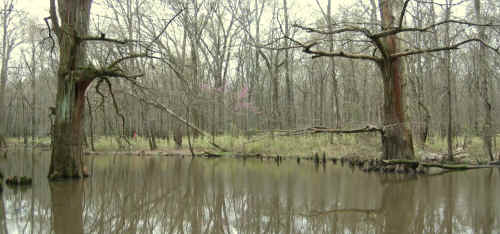
Ancient relic cypress with cherrybark oak on bluff
Fifteen miles north of Memphis, Meeman-Shelby Forest State Park
protects approximately 13,000 acres of mostly forested land
along the
Mississippi River. That area includes 9,000 of floodplain and
4,000
acres of Chickasaw Bluff Number 3. The bluff, slightly over 100'
high, consists of silty sediments driven by winds from the west.
Consequently, water easily erodes the unconsolidated sediments,
and
small streams have incised a network of branching, narrow
ravines into
the bluff leaving broad, flat-topped ridges between them. Water
flowing from the smaller ravines leaves little impression on the
floodplain while the larger streams form the bayous that meander
across the floodplain towards the river. Overall, the floodplain
features fewer bayous and is flatter than smaller river
floodplains in
the southeast. Elevation changes of only one to two feet produce
broad inundated areas whereas many smaller floodplains have more
confined wet areas associated with elevation changes of
approximately
five feet.

140'+ cottonwood and sycamore
We only had time to explore a fraction small fraction of the
floodplain near the bluffs, and species composition near the
river may
be markedly different. Cherrybark oak, swamp chestnut oak, and a
variety of other hardwoods dominate some areas, but eastern
cottonwood
is the most common species over larger areas. Sycamores
frequently
grow amongst the cottonwoods and pecan forms a lower canopy
below the
faster growing trees. Other canopy layers are largely absent,
but
within 500' of the base of the bluffs, boxelder forms a well
developed
midstory. Chinese privet, spicebush, free standing tangles of
greenbrier are locally abundant, but the understory is largely
open.
Other common vines include trumpet creeper and Virginia creeper,
which
hang off of many trees and reach large sizes. The forest floor
ranges
from grey cottonwood leaves to a cover of some short, yellow
flowered
spring ephemeral that resembles the Dicentras. A few stout, low
branching, odd baldcypress remain along the edges of depression
and
bayous, but most of the forest appears 70 to 90 years old.

Ancient cypress knees |

Relic cypress; 22'11" X 120.6' tall
|
A forest of similar age occurs on the bluffs comprised of
species
typically termed bottomland hardwoods, even on the ridge tops.
Cherrybark oak and white oak grow abundantly on the ridges and
upper
slopes while tuliptree and beech are more prevalent in the
ravines.
Some of the larger ravines have flat areas in the bottom where
species
more common in the floodplain, like sycamore and cottonwood,
also
thrive. The midstory is sparse throughout and the understory is
poorly developed in many areas, but red buckeye covers some
ravines.
In early spring, trilliums and a Claytonia are among the most
common
herbs.
On both the floodplain and the bluffs, many other tree species
occur
at lower densities; in one day of tree measuring, we saw 61 tree
species.
A fuller, but less site specific description of the
forests
can be found at
http://www.natureserve.org/explorer/servlet/NatureServe?searchCommunityUid=ELEMENT_GLOBAL.2.721881.
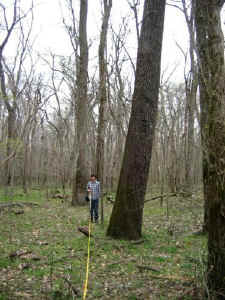
Measuring crown spread on a huge persimmon |
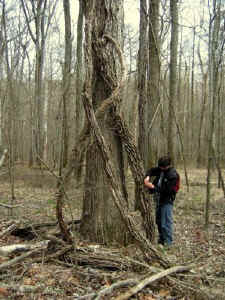
One of many huge Virginia creepers
|
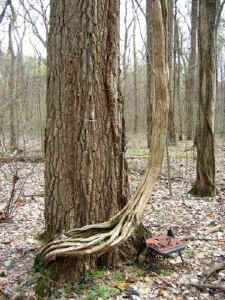
Trumpet creeper on 149' cottonwood |
Floodplain forest
Species Cbh Height
Baldcypress 22'11" 120.6'
Baldcypress NA 121.7'
Boxelder 6'11" 89.0'
Boxelder 5'0" 89.6'
Boxelder 7'8" 91.7'
Boxelder 4'7" 92.7'
Boxelder 3'9" 93.5'
Boxelder 5'1" 94.7'
Boxelder 5'4" 95.9'
Boxelder 4'1" 98.3'
Boxelder 4'3" 101.3'
Cottonwood, Eastern 8'8" 134.3'
Cottonwood, Eastern 10'6" 141.9'
Cottonwood, Eastern 13'3.5" 142.8'
Cottonwood, Eastern 15'3" 146.1'
Cottonwood, Eastern 13'8" 147.1'
Cottonwood, Eastern 10'8" 147.8'
Cottonwood, Eastern 13'7" 148.7'
Cottonwood, Eastern 8'2" 148.8'
Cottonwood, Eastern 11'11" 149.4'
Cottonwood, Eastern 9'9" 149.7'
Cottonwood, Eastern 12'2" 150.0'
Cottonwood, Eastern 10'0" 151.4'
Cottonwood, Eastern 10'1" 153.6'
Dogwood, Swamp 1'1" 22.6'
Elm, American 10'6" 114.3'
Elm, Cedar 7'4" 99.3'
Elm, Cedar 8'4" 105.1'
Elm, Cedar 6'4" 106.8'
Honeylocust 5'8.5" 106.2'
Honeylocust 6'3" 107.1'
Honeylocust 9'0" 115.1'
Honeylocust 6'6" 115.4'
Honeylocust 11'8" 116.8'
Honeylocust 6'11" 120.6'
Honeylocust 9'1" 124.4'
Honeylocust 8'5" 124.7'
Honeylocust 8'2" 127.4'
Honeylocust 7'3" 129.9'
Maple, Red 11'2" 119.6'
Maple, Red 9'3" 121.1'
Maple, Red 8'10" 123.2'
Oak, Cherrybark NA 118.0'
Oak, Nutall 10'0" 115.8'
Oak, Nutall 11'5" 122.3'
Oak, Overcup 8'1" 119.1'
Oak, Overcup 9'10" 126.6'
Persimmon 5'2" 113.2'
Persimmon 6'0" 116.3'
Persimmon 7'6.5" 118.1'
Sycamore 8'11" 136.3'
Sycamore 9'8" 138.0'
Sycamore 7'2" 140.0'
Sycamore 8'1" 143.2'
Sycamore 13'0' 152.9'
Virginia Creeper 1'8" NA
Virginia Creeper 2'1" NA
Virginia Creeper 2'3" NA
The boxelders grew more upright and appeared much more vigorous
than
commonly seen in southeastern floodplains. They have little
dieback
in the crowns and consistently reach heights that would be
exceptional
for smaller river sites.

150 foot tall cottonwood with huge trumpet creeper
The cottonwood stands far surpass any stands of the species I
have
seen elsewhere. The stands extend unbroken over dozens of acres,
and
in places cottonwood forms pure groves. Those areas support an
unusual density of stems over three feet in diameter, all of the
overstory trees, and have average canopy heights of over 140';
prior
to these trees and one Bob Leverett found at Big Oak Tree State
Park
in Missiouri at the same time, no eastern cottonwoods had been
measured over 140'. The cottonwoods appear to have accumulated
that
great volume of wood in under a century.
The swamp dogwood is a potential national co-champion.
The cedar elms only grew scattered in the more oak dominated
sections
of the floodplain. The species was easily identifiable by their
dense, tortuous crowns of fine twigs.
 Classic Honeylocust
Classic Honeylocust
The long, large trunks of the honeylocusts were extremely
impressive
to someone accustomed to seeing the species only in ornamental
setting. The 129.9' height exceeds the few previously measured
individuals.
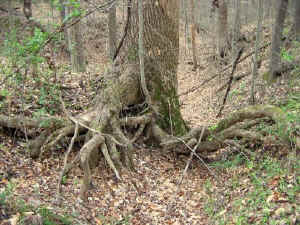 Tuliptree roots
Tuliptree roots
The red maples had the tight bark and dense crowns typical of
the
species grow in low elevation areas. They occurred primarily in
small
groups on the edge of depressions.
Bluff forest
Species Cbh Height
Basswood, White 6'10" 129.0'
Beech, American 9'1" 117.5'
Beech, American 8'9" 120.7'
Beech, American 7'5" 126.5'
Blackgum 6'5" 111.6'
Buckeye, Red 1'9" 33.1'
Buckeye, Red 1'9" 33.4'
Cherry, Black 9'0" 118.6'
Coffeetree, Kentucky 5'7" 115.8'
Coffeetree, Kentucky 4'7" 116.7'
Coffeetree, Kentucky 6'10" 121.2'
Cottonwood, Eastern 10'11" 154.4'
Elm, Red 4'10" 118.6'
Hickory, Bitternut 6'5" 119.9'
Hickory, Bitternut 6'11" 123.3'
Hickory, Bitternut 5'7" 128.9'
Hophornbeam, Eastern 2'9" 68.3'
Magnolia, Cucumber 5'3" 114.8'
Maple, Florida 6'7" 103.3'
Oak, Cherrybark 7'4" 127.2'
Oak, Chinquapin 6'6" 113.2'
Oak, Chinquapin 7'3" 113.8'
Oak, Chinquapin 5'11" 114.7'
Oak, Chinquapin Burl 115.6'
Oak, Chinquapin 8'5" 120.8'
Oak, Northern Red 6'1" 121.6'
Oak, Northern Red 5'5.5" 127.8'
Oak, Northern Red 6'9" 128.5'
Oak, Northern Red 8'1" 130.3'
Oak, Shumard 9'1" 134.4'
Oak, White 10'1" 127.2'
Oak, White 6'3" 131.0'
Sassafras 5'2" 112.8'
Sassafras 6'7" 115.5'
Sassafras 5'2" 118.5'
Sweetgum 7'7" 137.2'
Sweetgum 6'7" 137.8'
Sweetgum 8'9" 143.7'
Sycamore 8'1" 140.9'
Sycamore 9'1" 141.4'
Tuliptree NA 135.6'
Tuliptree 9'7" 139.1'
Tuliptree 9'4" 144.4'
Tuliptree 8'1" 145.9'
Tuliptree 10'6" 151.5'
Walnut, Black 7'0" 117.2'
Yellowwood 5'6" 83.0'
Yellowwood 5'2" 103.5'
The red buckeyes listed above grow in a small parking area;
understory
individuals only infrequently exceeded 10' in height.
The black gum is within one foot of the state height record.
ENTS previously had data on Kentucky coffeetree only from Beall
Woods
in Illinois. The Meeman-Shelby trees easily exceed the heights
of
those at Beall Woods.
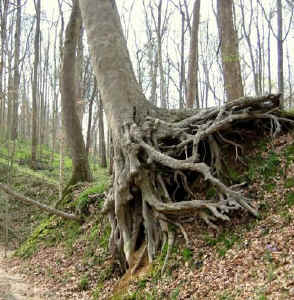
Beech roots: the loess just erodes away so large trees likely do not last long!
|
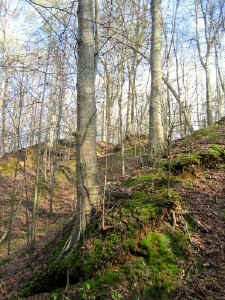
Beech clinging to the soft soils
|
Cottonwoods are far less common along the streams dissecting the
bluffs than in the floodplain, but the 154.4' tree in the bluffs
is
the tallest known eastern cottonwood.
The 120.8' chinquapin oak is a new state height record, and less
than
a foot shorter than the current height record for the species.
The white oak ties for the state height record.
ENTS has now measured five sassafras between 118' and 120' tall;
three
of those trees grow in the Smokies and the other two grow in
Meeman-Shelby.
The 103.5' yellowwood shatters the previous height record of
93.4'
held by a tree in North Carolina.
Rucker Height Index 138.6'
Eastern Cottonwood 154.4'
Sycamore 152.9'
Tuliptree 151.5'
Sweetgum 143.7'
Shumard Oak 134.4'
White Oak 131.0'
Northern Red Oak 130.3'
Honeylocust 129.9'
White Basswood 129.0'
Bitternut Hickory 128.9'
Rucker Girth Index 12.6'
Baldcypress 22.9'
Eastern Cottonwood 15.25'
Sycamore 13.0'
Honeylocust 11.7'
Nutall Oak 11.4'
Red Maple 11.2'
American Elm 10.5'
Tuliptree 10.5'
White Oak 10.1'
Overcup Oak 9.8'
The site is considerably more impressive than the Rucker Indexes
suggest. Several other southeastern sites surpass the height
index,
but the variety of species reaching great heights and the number
of
height records at Meeman-Shelby stand out as exemplary.
Additional
searching should substantially increase the indexes, especially
the
circumference index which was not a focus on this trip.
Jess Riddle & Will Blozan
|